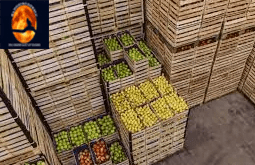Perishable food is any food that, because of its nature, age, or physical state, may spoil or otherwise become unfit for human consumption.
Fresh meats, processed meats, poultry, fish and other seafood, dairy products, bakery products, eggs in the shell, fresh fruits, and vegetables.
Food that has been gleaned, packaged, refrigerated, or frozen, food that has been canned, and prepared, or other food that has not been served to any customer, patient, or other people in the restaurant, cafeteria, hospital, hotel, caterer, or other food
service operation a fraternal, veteran’s, or other organization to its members or other persons on the premises in the ordinary course of the organization’s operation, or a college, university, or other educational institution to a student or another person on the premises in the ordinary course of the institution’s operation.
It is any food that, because of its nature, type, or physical condition, may spoil or otherwise become unfit for human consumption. Fresh or processed meats, poultry, shellfish, dairy products, bread products, eggs in the shell, and packaged or refrigerated foods are all examples of “perishable food.” Fresh fruits and vegetables, as well as canned or frozen items, are exempt from ORS 616.800 to 616.835 and 616.994.
How Perishable Food Items Are Shipped?

The dynamic demand-supply chain causes the movement of items between production and demand centers. Transporting commodities, whether perishable or non-perishable, causes meticulous preparation and execution.
Non-perishable goods are ones that don’t need to be refrigerated or stored in specific circumstances. When kept under normal storage conditions, they survive a long time.
Perishable goods, such as food, degrade and decay if we do not store them in the proper temperature-controlled environment. They have a short shelf life that can only be extended by storing them in the circumstances specified.
Perishable commodities include foods such as bread, fruits and vegetables, dairy products, meat and poultry, seafood, and pharmaceutical medications.
They must be stored in particular conditions and transported in clean, temperature-controlled containers. This is necessary to ensure that we maintain the quality of these things when they are transported from the factory to the market and to the final user.
Almost all pharmaceutical medications, besides a cool and dry storage environment, require protection from direct sunlight and moisture.
Similarly, some electrical equipment needs protection from heat, humidity, dust, and extreme temperatures. Any deviation from these guidelines can cause the products to deteriorate and spoil before they reach their expiration date.
Perishable commodities shipping has long been a logistical concern. It is difficult to coordinate the transit of such material between the supplier’s warehouse, the carrier, the customs and health authorities, and the buyer. Any miscalculations can cost the stakeholders a lot of money.
The most convenient way to move perishable commodities is by air, which is also the fastest means of transportation. It does, however, have certain restrictions.
Air cargo transport, for example, is more expensive than road, rail, or sea freight transport, and as a result, it may not be economically viable to convey a big volume of cargo by air.
Air cargo that companies who do not have their own cargo X-ray machines carry must wait for the obligatory cooling period of 24 hours before being loaded onto the plane. I do this for the sake of security.
Despite these constraints, airfreight is used to convey a variety of very perishable commodities.
Modern intermodal containers and temperature-control equipment have revolutionized perishable cargo transportation, particularly for perishable food goods. Reefers and refrigerated containers are two terms for temperature-controlled containers.
Refrigerated Containers

When cargo volumes and costs must be considered, transporting perishable merchandise by the sea in temperature-controlled intermodal cargo containers is the most preferred way.
We insulated reefers shipping containers featuring temperature-controlling equipment, temperature monitoring, and data-logging capabilities.
To maintain the cargo’s quality, they can regulate the temperature inside such containers. We can regulate sure inside such containers to the desired temperature.
We can program it to transport frozen meat at low to extremely low temperatures, or we can tune it to an ambient temperature range.
This would be determined by the sort of cargo being transported and the specifications set out by the item’s producer or manufacturer.
We transported meat and fish in -30°C refrigerated containers. Following the cleaning of the contains, the same container can transport ambient meal items at +24°C.
Condensation for perishable food
Condensation is a primary cause of perishable goods and their packaging deterioration and spoiling.
As a result, we must try to prevent condensation from forming during the loading and unloading of the cargo. Because of the temperature difference between the warehouse and the cargo container, this is when condensation is most likely to occur.
Pre-cooling a reefer container before loading perishable food items is a typical practice. To avoid condensation, we turn it off at the time of loading.
After loading, the container should have enough space for air circulation. Air circulation inside a cargo container keeps perishable items fresh and keeps the container at a consistent temperature.
It may enclose dry containers with insulated liners or vacuum panels to maintain the temperature of the loaded items in some situations, albeit this may not be the most efficient way of transporting perishable commodities over long distances.
We list other important variables to consider when shipping perishable cargo via sea freight below.
Timing for Perishable food
When shipping perishable goods, timing is crucial. Waiting time at ports, customs clearance, transportation, and other factors must all be considered when calculating the entire lag time. How long is the lead time? It’s the entire time to transport your cargo between two or more places. For planning and forecasting, lead time is crucial.
Stock expiration might occur if we do not consider delays in the lead time. This is where professional freight forwarders can help. We can avoid many of the above delays thanks to their experience and contacts.
For the transportation of perishable goods, better routes can be used. Perishable goods, which have a short shelf life, should be dropped off and picked up on time. Whenever a delay is anticipated or occurs, we should prepare plans for their temperature-controlled storage.
Quality Control and Technology
The items being shipped must be clean and in good condition. Contamination and spoiling can result from damaged or leaking shipments. The floor, interior walls, and doors of the container conveying such goods must be clean. It should be devoid of fungi and other microscopic organisms.
A thorough cleaning ensures that the container is free of odors that could be transferred to other cargo, such as food. To ensure that the door closes and seals the container precisely, the grooves of the door frame must be clean and even.
Perishable food commodities must maintain a cold chain during their travel. To track a shipment and arrange it, several technologies, such as Radio Frequency Identification (RFID), shipment tracking, and so on, can be employed.
Temperature and humidity sensors and monitors aid in the detection of breakdowns in refrigeration equipment while on the move, allowing for a prompt intervention to protect the cargo.
Instructions and Labeling
When delivering perishable food cargo, it’s critical to give precise instructions to individuals who will handle the items. Labels with handling and storage recommendations can aid in the preservation of perishable cargo’s quality and condition.
The storage and transportation circumstances of the items should be communicated to all key stakeholders, including the customer.
Temperature gauges can display temperatures in both Celsius and Fahrenheit. It should be specified if the cargo temperature is Celsius or Fahrenheit.
Every year, insurance firms deal with several cases of product damage caused by a mismatch in temperature settings.
The shipper and his service provider should discuss and agree on other arrangements to be made in the event of a contingency, such as sufficient storage space, labor, cargo handling equipment, and so on.
How to Inspect Perishable Food Items?

Each year, one out of every ten Americans contracts a foodborne illness because of a food service operation. Maintaining proper food safety management standards may assist you in avoiding potentially fatal food-borne illness outbreaks.
When products enter your facility, food safety management begins. Follow general reception and inspection requirements when accepting delivery of perishable food goods, but be aware that some food products have additional specialized guidelines.
How to Inspect Eggs:
- Clean, unbroken eggs are required.
- We must receive shell eggs at a temperature of 45 degrees Fahrenheit or less.
- For processed egg products, pasteurization is required (i.e. liquid eggs). The USDA inspection mark must be visible on these products.
- Salmonella, pasteurization destroys a pathogen typically found in eggs.
How to Inspect Milk and Dairy Products:
- We must receive it at a temperature of 45 degrees Fahrenheit or less.
- Check for any leaking milk bottles or soiled packaging.
- To avoid, eradicate, or minimize germs, milk should be treated or pasteurized.
How to Inspect Produce:
- Cut melons, tomatoes, and leafy greens must be received at a temperature of 41 degrees Fahrenheit or less.
- Be cautious of vegetables and fruits that have been processed (cut, washed, etc.) because germs might thrive on them.
- Keep an eye out for packaging that isn’t completely intact.
How to Inspect Pre-packaged Juice:
- Check for any leaking juice bottles or soiled packaging.
- To avoid, eradicate, or minimize germs, juice should be treated or pasteurized.
Gordon Food Service’s team of registered dietitians and qualified food-safety professionals provides customers with a variety of food safety tools and resources. Learn more about our food safety service offerings if you’re already a customer.
The Nutrition Resource Center
Tips for storing perishable foods
It’s a good idea to look into how long perishable items will last.
Here’s how long perishable foods can be safely stored in the refrigerator.
| Food | Time in the fridge |
|---|---|
| raw ground meat or stew meat | 1–2 days |
| raw sausage | 1–2 days |
| raw poultry | 1–2 days |
| raw fish and shellfish | 1–2 days |
| raw steaks, chops, and roasts | 3–5 days |
| bacon | 7 days |
| cooked ham | 7 days |
| hot dogs and lunchmeats | 2 weeks unopened or 1 week opened |
| chicken, egg, tuna, or macaroni salad | 3–5 days |
| cooked meat, poultry, or fish leftovers | 3–4 days |
| eggs (in their shells) | 3–5 weeks |
Other suggestions include:
- Go through your refrigerator once a week and throw out anything that has been there for too long.
- When storing perishable food items, keep your refrigerator clean. Any spills should be wiped up right away, then the surface should be rinsed with hot, soapy water. Keep an opened package of baking soda on a refrigerator shelf to reduce odors (which will not affect food safety but may influence taste).
- If the temperature outside is 90 °F (32 °C) or higher, refrigerate perishable food within 2 hours, or 1 hour if the temperature outside is 90 °F (32 °C) or higher.
- Separate raw meat, poultry, seafood, and eggs from the rest of your meals. To avoid contamination, store these goods on the bottom shelf of your refrigerator.
Temperature ranges and food kinds
Although some food safety experts claim that we can store certain nonperishable goods at room temperature without rotting, we must keep many foods within a safe temperature range to avoid bacteria growth.
Perishable food goods may become unhealthy to eat if stored at temperatures higher than 40°F (4.4°C), which could happen if you keep them in a location other than the fridge or freezer.
Seafood, poultry, meat, eggs, dairy, and cooked leftovers are examples of perishable foods.
To keep you safe, we must keep these foods at a specific temperature.
The chart below shows suggested perishable food storage temperatures and internal cooking temperatures when applicable.
| Storage temperature | Safe minimum internal cooking temperature | |
|---|---|---|
| Poultry | 40°F (4.4°C) or below, or frozen at 0°F (-17.7°C) or below | 165°F (73.8°C) |
| Leftovers (stuffing, casseroles, etc.) | 40°F (4.4°C) or below, or frozen at 0°F (-17.7°C) or below | 165°F (73.8°C) |
| Egg dishes | 40°F (4.4°C) or below, or frozen at 0°F (-17.7°C) or below | 160°F (71.1°C) |
| Ground meat | 40°F (4.4°C) or below, or frozen at 0°F (-17.7°C) or below | 160°F (71.1°C) |
| Beef, pork, lamb, veal, steaks, and chops | 40°F (4.4°C) or below, or frozen at 0°F (-17.7°C) or below | 145°F (62.8°C) and allow to rest for at least 3 minutes |
| Ham, fresh or smoked (uncooked) | 40°F (4.4°C) or below, or frozen at 0°F (-17.7°C) or below | 145°F (62.8°C) and allow to rest for at least 3 minutes |
| Fish and shellfish | 40°F (4.4°C) or below, or frozen at 0°F (-17.7°C) or below | 145°F (62.8°C) |
| Dairy products | 40°F (4.4°C) or below, or frozen at 0°F (-17.7°C) or below | N/A |
| Most fresh fruits and vegetables | 40°F (4.4°C) or below, or frozen at 0°F (-17.7°C) or below | N/A |
Keep in mind that we can only keep perishable food items refrigerated for a limited time at temperatures of 40°F (4.4°C) or below.
We should keep fresh poultry in the refrigerator for only 2 days, while we should keep raw eggs in the shell for only only 5 weeks.
food safety experts
What you can do to keep your food safe?
home: While it’s hard to avoid all potential food-borne diseases, there are precautions you can take to keep your food safe to eat.
Here are some simple techniques to make sure you’re storing and cooking food securely at home:
- We should keep food that is hot. Hot food should be kept at or above 140°F (60°C).
- We should keep cold food cold. We should keep food cool at or below 40°F (4°C).
- Properly cook meat, seafood, and poultry. We should always cook meat and other perishables to a safe internal temperature.
- For leftovers, be cautious. Within 2 hours of cooking, refrigerate leftovers at 40°F (4°C) or below.
- Reheat in a safe manner. Before eating, reheat food to an internal temperature of 165°F (73.8°C), or until hot and steaming.
- Monitor the storage temps. Keep your refrigerator and freezer at 40°F (4.4°C) or lower and 0°F (-17.7°C) or lower temperatures, respectively.
- Use airtight containers. To keep fridge bacteria out of your food, use glass or plastic storage containers with sealing.
Risk of foodborne illness
The most dangerous of acquiring a food-borne illness, sometimes known as food poisoning, when eating raw meat is contracting a food-borne illness.
Eating food infected with bacteria, viruses, parasites, or poisons causes this. Typically, this contamination occurs during slaughter when the animal’s intestines are accidentally nicked, allowing infections to travel to the flesh.
Salmonella, Clostridium perfringens, E. coli, Listeria Montagnais, and Campylobacter are all common infections found in raw meat.
Nausea, vomiting, diarrhea, abdominal cramping, fever, and headache are all symptoms of foodborne sickness. These symptoms appear within 24 hours and can continue up to 7 days — or even longer in some situations — depending on the infection.
Properly cooked meat kills microorganisms that could be hazardous. Pathogens persist in raw meat. As a result, eating raw meat significantly increases your risk of contracting a foodborne illness, so proceed with caution.
Children, pregnant or nursing mothers, and the elderly are among those who should avoid consuming raw beef completely.
What are the 20 perishable food examples?
- Milk
- Tomatoes
- Fish
- Chicken
- Fresh vegetables (lettuce, carrots, celery..etc.)
- Cottage cheese
- Bread
- Cooked grains (oats, grits, rice, Farro, etc.)
- Fresh fruits
- Eggs
- Chocolate (it will turn/separate from the fats and milk solids by month 3 or 4) turns to crumbled chalky dust.
- Mushrooms (fresh)
- Yogurt
- Lunch meats
- Stews
- Sauces
- Frosting
- Sour cream
- Potatoes
- Beef
FAQ
What are five perishable food examples?
What is the difference between perishable and non-perishable food?
What makes all foods perishable?
Is it true that sweets are perishable?
Disclaimer: The information provided here is for educational/awareness purposes only and is not intended to be a substitute for medical treatment by a healthcare professional and should not be relied upon to diagnose or treat any medical condition. The reader should consult a registered medical practitioner to determine the appropriateness of the information before consuming any medication. Elnodi does not provide any guarantee or warranty (express or implied) regarding the accuracy, adequacy, completeness, legality, reliability, or usefulness of the information; and disclaims any liability arising thereof.





